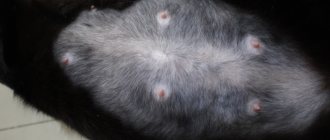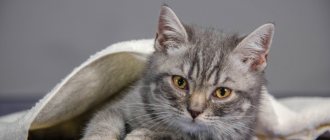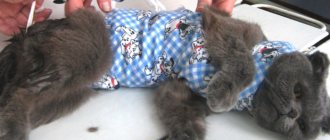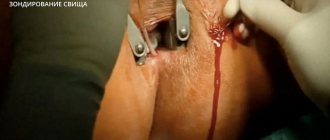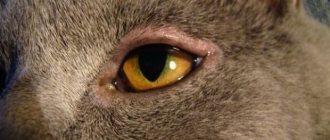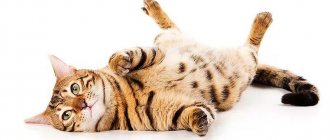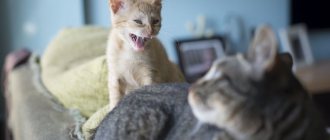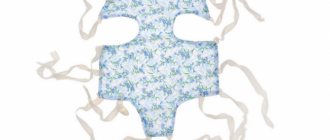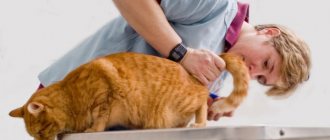Sterilization and castration are popular surgical procedures among cat owners that can solve many problems associated with sexual heat in pets. Despite the fact that these procedures have long become routine, they remain operations after which animals require recovery.
One of the most common post-operative problems is a lack of appetite in your pet. Why doesn't a cat eat after castration or sterilization? When should a tailed friend recover after surgery? How long after it should start eating and drinking? What to do if your pet refuses food and water?
Possible postoperative complications
If a cat does not eat or drink after surgery, this makes the owners worry, so the question arises of how to help their pet and whether this may indicate the presence of serious complications.
After sterilization, it takes time to recover
It is absolutely normal for a cat to eat poorly after sterilization or a cat after castration during the first 24 hours. All the animal does is sleep and sometimes get up to drink some water.
Important! If the animal cannot get up on its own to drink water, then it must be given water periodically.
In addition, there is no need to panic if the cat goes to the toilet under itself or vomits; this is also quite possible until the threads are removed from the seam. Veterinarians recommend that owners do not touch the cat during the first two days and, if it does not want to eat, there is no need to force food. The animal will be able to go without food for several days, while its body will use up previously accumulated calories to maintain satiety.
The postoperative period will be painful for the cat, but it will gradually recover. In addition, she will receive injections to maintain fluid balance.
The animal needs to be allocated a secluded corner that will be quiet and calm so that the cat can rest and get enough sleep. You should definitely put a bowl of fresh food nearby.
Note! If there are other animals in the house besides the cat, they must be isolated until the sterilized animal is completely restored.
If a cat does not eat or drink for several days after sterilization, then you should urgently seek veterinary help, because such a condition may indicate the development of serious diseases.
Postoperative complications may be as follows:
- development of sepsis;
- intestinal atony or obstruction;
- kidney or liver problems;
- hernia;
- inflammation of the peritoneum;
- infectious infection;
- suppuration of the sutures or their divergence.
Complications after surgery can be different.
If even one negative symptom appears, you must seek help from a specialist; treatment at home is unacceptable, because there is a threat to the pet’s life.
Postoperative collar – effective suture protection
During recovery, it is important to ensure that the incision site remains intact: the cat should not lick itself. A postoperative (Elizabethan) collar will help protect the sutures or bandage from harmful intrusions. It is a funnel-shaped structure that is placed around the pet’s neck. The protective edge prevents the cat from licking itself, but at the same time does not interfere with food intake.
An Elizabethan collar for a cat can be purchased at a pet store or you can make it yourself from an old large plastic bottle or thick fabric. In this case, the height of the side should correspond to the distance from the neck to the tip of the animal’s nose.
The cat does not eat or drink for a long time: the main reasons for refusing water and food
If the cat feels weak, does not touch food even for 2-3 days
If the cat feels weak and does not touch food even on the 2-3rd day, food is administered intravenously or fed with broth from a pipette.
In the postoperative period, it is recommended to give non-solid, easily digestible foods. If a cat has been eating dry industrial food, it is switched to soft food. Some animals' taste preferences change and they give up their favorite foods.
If the cat does not eat or drink for several days after surgery, this becomes an alarming signal. Sometimes hospitalization is recommended so that the animal is under medical supervision around the clock.
Cats are quite intelligent animals with a decent instinct for self-preservation. They will never eat everything in a row; they are extremely careful when choosing food. But there are times when the appetite completely disappears.
At first glance, it is difficult to determine why a cat has not eaten or drunk for several days. This may also be accompanied by additional symptoms - a serious reason to take emergency measures. You can determine the condition of your pet by its appetite.
Below we have given you a video example where a cat fell ill with distemper and stopped eating and drinking water. Look at the general condition of the cat, perhaps the symptoms may be similar!! In the video, the owner recommends the medications that the doctor prescribed for her. Be sure to consult a veterinarian!
According to veterinarians, temporary hunger strikes in animals are acceptable and not painful. These factors include:
- A kitten may not eat anything for one day. This rule applies to animals under 6 months of age. If he continues to refuse food, adequate measures must be taken.
- Healthy young pets can refuse food for 5 days. This “diet” is absolutely safe for the body, provided there are no obvious signs of illness. If your cat begins to burp, vomit, diarrhea, lose weight quickly, refuse fluids, or a week has passed since her hunger strike, immediately contact the veterinarian!
- An old cat may not eat for three days. A longer hunger strike indicates the development of chronic diseases. In this case, you can’t do without the help of a specialist.
There are other reasons that cause an animal to temporarily refuse food. Let's look at them in more detail in our article and find out why cats refuse food for several days and how to help them in this situation.
The beloved fold-eared pet with a good-natured face and a trusting look suddenly began to refuse his favorite treats. Atypical behavior for pets makes the owner nervous. Naturally, every caring owner tries to find out why a domestic kitten is not eating.
The worst thoughts immediately come to mind, and we intuitively run to specialists for help. However, there is no need to rush; it is necessary to exclude all possible reasons that could cause a change in the appetite of a furry family member.
Pets develop taste preferences over time. They quickly get used to their daily diet and do not always give in to experiments involving a sudden change in diet. If you have recently changed your pet’s usual food to a new composition, your cat may refuse to eat on principle, showing his dissatisfaction. Loss of appetite can also occur due to the introduction of new foods into the diet.
So, unfamiliar food is one of the reasons why a furry family member may go hungry for several days. If the food remains the same, look into your pet's bowl to see if there are leftovers from the previous meal or poorly washed edges.
A clean animal may refuse food after smelling the unpleasant smell of rotting remains. Take care of the hygiene of dishes for your pet. A dirty bowl can not only affect his appetite, but also provoke the development of certain diseases.
You feed it its usual food, thoroughly clean the bowl after each feeding, follow all the doctor’s recommendations, but the animal does not develop an appetite. The cat refuses to eat, and the cause of this condition may be stress or pain.
What is this connected with? There is no definite answer; you will have to draw your own conclusions. Stress in cats occurs for various reasons:
- moving to a new home;
- rearrangement of furniture in the house;
- replacing the usual dishes with another;
- the appearance of a new family member in the house, etc.
In such an environment, the cat can feel safe and eat. Be sure to provide her with something to drink. If she continues to refuse food for more than 3-5 days, contact your veterinarian. An experienced doctor will be able to determine the exact cause of the hunger strike and find a solution to this problem.
A domestic cat may not eat well if it has dental problems. This cause of loss of appetite is very common. A clear sign of pathology: the animal may drink a lot of liquid, choke on food, burp after eating solid food, etc. Loss of appetite occurs due to a lack of teeth in a row, which provokes the development of certain diseases of the gastrointestinal tract.
The source of such problems can also be dental caries, gum disease, tartar accumulation and other dental ailments typical of humans. To prevent such conditions and not to risk the health of a purebred cat, carry out hygienic care of its oral cavity in a timely manner. If you detect obvious signs of an inflammatory process, consult a doctor.
If dental disease has already caused loss of appetite in your beloved cat, try to choose the optimal set of foods for feeding. Eliminate solid foods, grind all food served, and be sure to consult your veterinarian. Your friend may need medication help.
You can understand that an animal has been poisoned if the cat refuses to eat for several days, which is also accompanied by a gag reflex, lethargy, muscle tremors and other unhealthy signs. Due to poisoning and painful symptoms, the cat may hide, meow loudly, or simply lie down without showing active signs of life. Any atypical symptoms should not be ignored.
Poisoning can be caused by various chemicals, low-quality products, medications, etc. A dangerous substance could enter the animal’s body accidentally or intentionally. A cat can swallow bait containing poison, which is possible if the pet has free access to the street.
| Video (click to play). |
The culprit of this process can also be the owner of a furry friend, who unintentionally fed the cat spoiled food or food containing components unsafe for the animal.
If the reason for refusing to eat is poisoning, it is necessary to take urgent measures to save the four-legged family member! An experienced veterinarian will prescribe effective treatment so that your pet can recover.
The main thing is not to hesitate, since in case of poisoning with chemical poisons, irreversible processes in the body can begin, which lead to the most unfavorable prognosis.
Poor appetite in a domestic cat may indicate the development of pathological processes in the liver, kidneys and urolithiasis, which often occurs due to poor quality nutrition. According to statistics, such diseases are diagnosed in felines three times more often than in dogs.
You can determine exactly what the problem is by the following symptoms:
- the cat behaves lethargically, the condition noticeably worsens;
- can drink large amounts of water at one time;
- there is an unpleasant odor from the mouth;
- frequent urge to urinate;
- there are blood impurities in the urine;
- vomit;
- convulsive conditions;
- elevated temperature;
- weight decreases;
- if you stick out your tongue, you will notice an uncharacteristic yellow coating;
- increased salivation;
- anemia and signs of dehydration.
With such symptoms, the animal must be urgently shown to a specialist!
Forecasts for the animal:
- Kidney diseases can be treated if promptly consulted by a veterinarian;
- if the disease is advanced, there is a possibility of becoming chronic, which will require regular support for the cat’s health to prolong and improve the quality of its life;
- With liver diseases, obesity is observed, which also negatively affects the general condition of the pet and shortens its lifespan.
Even if your cat is sick, do not rush to part with your furry friend. Provide her with the necessary help, provide care and love, because any disease can be treated, especially if you are next to her during this difficult period!
What to do if your domestic cat does not eat at all due to a foreign body entering the stomach:
- do not try to feed your pet (severe vomiting may occur);
- do not do an enema yourself (there is a risk of serious damage to the intestines);
- do not give your cat antiemetics or laxatives, as they will not solve the problem and will only worsen the general condition;
- Seek help from a qualified veterinarian as soon as possible!
Any foreign body can enter the animal's body, including indigestible sausage skins, scraps of wool and bones. This is a very dangerous condition for the animal, known as intestinal obstruction. If timely medical care is not provided, there is a high risk of death.
The death of a pet occurs due to the release of gastric juice and its stagnation in the intestines. An unfavorable process is accompanied by vomiting, the abdomen becomes enlarged, and when pressure is applied the cat experiences severe pain. Do not try to solve the problem yourself; any wrong action can lead to irreversible consequences.
Anesthesia is the cause of lack of appetite
Cat after sterilization: care at home
During surgery, veterinarians use general anesthesia as it helps numb the surgical site. Another advantage of anesthesia is that the cat will not escape from the operating table and will not inflict even greater injuries or mutilation on itself.
But the effect of anesthesia after the operation does not go away without a trace, and the cat recovers from it for a long time: it may take a long time to wake up, breathe heavily, eat nothing and move unsteadily - and all this is the norm.
In rare cases, an animal can be in a comatose state for a week: refuse to eat, sleep constantly and practically not move. But all this goes away over time without additional help.
If a cat does not drink water after anesthesia, then this is also quite normal, since it may vomit after drinking water or food. Therefore, you should be patient, and very soon your pet will recover.
What to do if your cat doesn't eat well
So what to do at home? The choice is not too wide:
- Try to “lure” the cat’s appetite using the most delicious and pleasant-smelling food.
- If a cat has poor appetite and has rare and irregular bowel movements, you can use Duphalac 0.5 ml per kilogram of live weight. The course of treatment is once a day, for three days.
In other cases, especially if the animal does not feel particularly well, we recommend contacting a veterinarian. It is very likely that we are talking about some kind of postoperative complications. And you don’t need to wait a week for this!
Preparing for surgery
To minimize risks, the cat must be checked, undergo the necessary tests, and, if everything is in order, prepared for surgery.
Since cat spaying is an operation that is done under general anesthesia, it is best to schedule it in the morning so that you can keep an eye on your cat while she recovers from the anesthesia, which will take several hours. Prepare in advance the place where you will place the cat after the operation, and the basket with which you will bring the cat home.
The cat will tolerate anesthesia more easily on an empty stomach, so 12 hours before the operation it is necessary to put the cat on a forced hunger strike. You need to take this seriously: a hunger strike will help avoid vomiting during surgery and reduce the load on the animal’s heart. Get your pet's stomach to empty; consult your veterinarian about how to do this. The cat can be given something to drink 3 hours before surgery.
What to do if the animal refuses to eat
Owners begin to worry if the cat does not eat after surgery, what to do in such a situation and why does this happen? In this case, you should consult a specialist, as complications may arise.
How long does it take for a cat to recover from anesthesia after sterilization: how you can help
The animal must be fed three times a day with kefir, broth or meat puree, but in small portions. This can be done using a syringe without a needle, pouring food carefully into the cheek. It is also recommended to place an intravenous drip with nutrition.
Important! If the cat does not eat anything or go to the toilet for a long time, it means that some complication could have developed.
It is very important to ensure that your cat goes to the toilet regularly, because constipation can cause her to refuse to eat. To determine whether the cause is really constipation, it is worth palpating the stomach and, if there are lumps, give an enema or give the animal a laxative.
Refusal to eat after surgery usually lasts several days
After the operation, the cat must be wearing a blanket, which prevents licking the wound and scratching it. The owner’s task in this case is to care for the wound, since its deterioration can also affect the animal’s complete lack of appetite.
If no complications were confirmed by the veterinarian, then after 10 days the pet will be able to fully recover and begin to eat normally.
Rules for feeding a cat in the sterilization field by day
The veterinarians at the clinic will learn about feeding rules. This is especially true for the consistency and quantity of food, because food can put pressure on the walls of the abdominal cavity, the site of the operation.
Anesthesia slows down intestinal motility, which prevents the passage of undigested food. As a result, food ferments and rots, the cat suffers from gas formation, bloating, and poisoning.
Therefore, veterinarians recommend giving the animal its first food the day after surgery and ensuring it drinks plenty of fluids to avoid dehydration. Otherwise, the blood thickens, it stagnates in the chambers of the heart, and the blood supply slows down.
Sometimes this condition leads to death, the heart stops.
Rules for feeding a sterilized pet after surgery by day:
| Day | What to feed |
| First | The cat is given a lot to drink and is not insisted on feeding |
| Second | Give a portion of food not exceeding 1/3 of the standard portion. You should not give heavy food, since the animal cannot push after surgery. All products must be fresh so as not to harm a weakened body |
| Third | As a rule, on the 3rd day the pet itself asks for food. The portion is gradually increased, but should not exceed 130 g, since sterilized cats are prone to obesity The pet can fast even on the 3rd day, but at the same time she feels good: she is mobile and behaves as usual. In this case, owners do not need to worry. You can offer your pet another food or add a few drops of fish oil for appetite. It is necessary to monitor whether the cat went to the toilet or not. In some cases, she refuses to eat due to constipation. You need to lightly feel the stomach: if there is a lump, you can do an enema or give a laxative |
If your pet does not touch food on the 4th day, you should immediately contact a specialist. There are cases when an animal immediately after sterilization begins to eat normally, but on the 4-5th day it stops eating.
In such a situation, you need to measure body temperature, examine the mucous membranes, and look at the color of the suture. If the mucous membranes are pale and bluish, and the suture is red and purulent, the cat should be shown to a veterinarian.
How long after the procedure should a four-legged patient start drinking and eating?
If the operation is successful, the operated animal drinks water and eats on its own on the second day. During this period, it is recommended to feed your four-legged pet in small portions. In the first few days after surgery, your pet's appetite may be significantly reduced. Normally, it should fully recover within 6–7 days. By this time, most animals are already beginning to experience the same interest in food, and their bowel and bladder emptying processes are normalized.
Nuances of postoperative care
The owner needs to provide proper care for the cat after sterilization. And this care includes not only a healthy diet and treatment of postoperative sutures, but also other important procedures that contribute to the rapid recovery of the cat.
Can a cat walk and jump after sterilization?
The first day after surgery is the hardest. The owner needs to be close to her at all times. Due to the effects of anesthesia, the cat’s coordination of movements and consciousness are impaired, so it is important to monitor its gait and prevent the cat from falling, especially from a height. It is recommended to prepare a sleeping area for the cat on the floor with a clean towel or blanket. Under no circumstances should you place a cat in places where there are drafts, or allow sudden movements of the animal.
For the first five days after surgery, cats should not jump or play active games. It is recommended to avoid jumping on high surfaces for 10-14 days after sterilization. The owner needs to regularly monitor the pet’s behavior until it is fully restored.
Already on days 6-7, the cat can be walked outside, but only under supervision. A walk in the fresh air will benefit the body.
After how many days can I bathe?
After a surgical procedure, the cat should not be bathed until the wound has completely healed. The first bath procedure should not be carried out earlier than 14 days after sterilization. To wash a sterilized cat, it is recommended to use special dry shampoos.
If, after sterilization, dried blood or ichor remains on the cat's body, the owner can carefully remove the contamination using Chlorhexidine or hydrogen peroxide. To clean wool, you can use potato starch, gently rubbed into the animal's coat.
What else can and cannot be done after surgery
Many owners do not know how to properly care for a cat after sterilization, and often make serious mistakes that can cause some harm to the health of the animal. Let's look at what you can and cannot do after sterilization.
Can:
1. The owner can carefully pick up the cat, picking it up by the front and back legs at the same time, without pressing down or putting pressure on the operated area. 2. Walk the cat outside under supervision. 3. Give your cat medications with an analgesic effect, but only on the recommendation of a doctor.
It is forbidden:
1. When picking up, lift the cat only by its front paws.
2. Treat seams with alcohol-containing solutions. 3. Overfeed the animal. 4. Allow the cat to sleep near heating devices or on a radiator. 5. Play actively with the cat. 6. Remove the blanket if the wound is not yet healed and the stitches have not been removed. 7. Overfeed the cat. 8. Give her fatty and hard-to-digest foods that cause digestive problems. After sterilization, an experienced veterinarian will explain in detail to the owner how to properly care for the cat in order to eliminate any risks of postoperative complications. If these rules are followed, the animal will quickly recover from the surgical procedure and will soon return to its normal life!
Feeding after surgery
In order for your cat to recover quickly after surgery, you should monitor its diet. Proper nutrition is the key to a quick recovery and prevention of complications.
The cat does not drink water at all: what to do, why
During the first two days, the animal may not eat anything at all, and this is normal. During the first day, the cat should not be given solid food; it is better to cook broths or soups. On the second day, you should start feeding with soft food or crush the food into a puree. It is recommended to feed in small portions 3-4 times a day.
After surgery, the animal loses a lot of minerals and vitamins and it is very important to compensate for their deficiency in the body, so experts recommend buying special cat food that has high nutritional value and a balanced composition.
If the animal eats homemade food, then you should avoid foods with a strong smell and spices. It is also prohibited to give dry food during the postoperative period; it must be pre-soaked with water, but the main emphasis after the operation should be on eating canned meat and purees.
Important! When feeding your cat, you should make sure that the food is neither hot nor cold. It should be at a comfortable temperature for consumption.
How and what to feed a cat after surgery?
The operation is performed under anesthesia. After waking up, the animal is desoldered from the syringe. It is better to offer food every other day, do not insist in case of refusal.
The preferred food on the first day is fermented milk products, porridge, boiled minced chicken. Subsequently, it is allowed to give low-fat meat broths, fruits and vegetables, boiled offal, and cereals. All ingredients are combined. It is especially important to ensure you drink plenty of fluids. The cat should have access to water around the clock.
Modern dry food manufacturers produce special food for sterilized cats . They contain all the necessary microelements and immunostimulants.
Modern dry food manufacturers produce special food for sterilized cats.
It is strictly forbidden to give during the postoperative period:
- fish;
- semolina, oatmeal;
- full-fat milk, sour cream, cream;
- fried food;
- smoked meats, sausages.
Raw meat is given in the form of minced meat. Veterinarians do not recommend mixing natural food, industrial feed, or overfeeding the animal. If your pet is fed home-cooked food, then mineral supplements and vitamins must be included in complementary foods.
Be sure to read:
A sterilized cat asks for a cat: reasons, when is it the norm, what to do, how to avoid
How to process seams
It is very important to keep the seams clean and prevent infection and inflammation. The bandage should be changed to a clean one every day, and the seam should be treated daily with the antibacterial agent “Argumistin”, which will prevent inflammation, fungus, and infection with microbes during periods of particular danger.
The use of "Argumistin" has a number of advantages:
- eliminates the main cause of the disease;
- has an anti-inflammatory effect;
- activates the regeneration process;
- does not contain antibiotics;
- does not cause addiction in cats;
- ease of use;
- optimal price.
Monitor the progress of healing, treat the sutures daily, and in case of the slightest deviation, consult a doctor. The sooner complications are detected, the easier it is to prevent possible danger.
Rules for feeding a sterilized cat
It is necessary to start feeding the cat only 12 hours after surgery, since during this time the animal’s gastrointestinal tract does not work well, and it may vomit after eating.
When compiling further menus, it is imperative to take into account how the animal ate before sterilization. The most acceptable are cat foods, since they contain balanced components necessary for a pet.
Food for a sterilized cat
- First day. A cat does not eat well after sterilization for 24 hours; this is normal. This is the period when the animal is completely exhausted and cannot show interest in food or water. You can give your cat water a few hours after the operation, but before that you can only moisten a little sponge or drop a couple of drops of water on the tongue to avoid dehydration.
- Second day. If there are no complications, the animal may begin to show interest in food, and it is worth feeding it with special cat food. You should choose those whose action is aimed at restoring the body after operations or illnesses. It is worth opting for canned food such as Royal Canin, Hill's, Purina, etc. But if before the operation the animal was home-fed, then it should be boiled chicken broth and add a little twisted meat.
- The third day. The cat should begin to eat on its own without any help. But if this is not observed, you should pay attention to the pet’s behavior. If she meows, there is an unpleasant odor coming from the stitches, or the wound is bleeding, then the animal should be immediately shown to a doctor.
- Fourth day. If the cat still does not eat anything, then this most likely means the presence of complications such as peritonitis, sepsis or problems with the gastrointestinal tract. If the cat ate normally for the first four days, and then suddenly began to refuse to eat, this may mean the occurrence of delayed intestinal atony or problems with the liver or kidneys. The fourth day without food after surgery may mean that the cat is dying, so you need to drop everything and run with it to the veterinary clinic.
- Fifth day. You can already start giving everything that the animal ate before surgery. But if during the first five days the cat took food reluctantly, and sometimes even refused it altogether, then it can lose a lot of weight, and in this case it is necessary to introduce high-quality food into the diet and take additional medications that are prescribed only by a veterinarian.
Many animals recover easily and quickly after surgery.
If the cat does not drink after sterilization or does not eat anything after two days, then you should seek help from a veterinarian, who will identify the complication in time and give further recommendations for treatment.
Recovery period
After a correctly performed procedure, the animal should recover within the first 24 hours. It is necessary to provide care, access to water and liquid food; when the cat recovers from anesthesia, he will begin to eat and drink on his own. After surgery, the animal should sleep as much as possible, then it will recover faster . Children and other pets should not be allowed near it. It is better if the kitten's sleeping place is on the floor on a special bed. Then the risk that he may fall from a height and be injured will be minimized. Some individuals may become so disoriented that they will begin to hide in inaccessible places and try to climb onto a cabinet. This should not be allowed; the kitten may fall or damage the seam.
© shutterstock
If your pet refuses food and water after castration, the reason may lie in the nausea that he experiences, he needs to be given time.
Usually, even if a cat does not eat after castration, he drinks a lot of fluids, feeling thirsty after anesthesia. There are a number of symptoms that should alert pet owners if they persist two days after the procedure:
- manifestation of nausea, vomiting or urge;
- bowel dysfunction, constipation or diarrhea;
- constant desire to sleep;
- lack of appetite and reaction to external stimuli;
- disorders of the vestibular apparatus;
- fever and chills;
- redness or blanching of the mucous membranes.
After the removal of the gonads in a kitten, the hormonal background of the entire body changes completely, this takes time, and if the cat eats little after the operation, this may indicate a change in metabolism.
How to process seams
It is very important to keep the seams clean and prevent infection and inflammation. The bandage should be changed to a clean one every day, and the seam should be treated daily with the antibacterial agent “Argumistin”, which will prevent inflammation, fungus, and infection with microbes during periods of particular danger.
The use of "Argumistin" has a number of advantages:
- eliminates the main cause of the disease;
- has an anti-inflammatory effect;
- activates the regeneration process;
- does not contain antibiotics;
- does not cause addiction in cats;
- ease of use;
- optimal price.
Monitor the progress of healing, treat the sutures daily, and in case of the slightest deviation, consult a doctor. The sooner complications are detected, the easier it is to prevent possible danger.
Conjunctivitis in dogs
Endometritis in dogs
Diabetes mellitus in cats
Endometritis in cats
What is important to pay attention to?
It is not recommended to leave a cat unattended near water bowls, mugs and other utensils with water. Basically, after sterilization, a cat drinks little, but animals still have situations of excessive thirst, so there are certain risks. After sterilization, the animal’s swallowing reflex is disrupted; it drinks water inaccurately , so it may choke. Or just fall asleep with your head falling into a bowl of water. In this case, the owner will need to monitor the pet’s behavior in order to prevent this from happening.
Why does a cat need water?
Unlike other animals, cats - tigers, lynxes, leopards, panthers and other species of this kind of predators - can get by with a small amount of liquid: they lose less water during breathing than, for example, representatives of the canine family. But the need for water is also vital for low-drinking cats; water balance directly affects their vital activity and vitality.
An inorganic compound called hydrogen oxide makes up 65% of a cat's body weight. Water enters the structure of cells and extracellular fluid, transports nutrients and oxygen to tissues, and participates in thermoregulation. If the natural loss of fluid is not replenished, this can lead to disruption of metabolic processes, and prolonged dehydration can lead to irreversible changes in the internal organs and death of the animal.
The cat's daily water requirement is approximately 60 ml per 1 kg of weight. That is, a three-kilogram cat needs to drink half a glass of liquid per day. This includes clean water the cat drinks and water contained in wet food or soup.
When can you give a cat water after sterilization?
When picking up your cat from the clinic, you should check with your veterinarian when you can drink water after sterilization.
Typically, experts do not recommend giving the animal water within three hours after waking up from anesthesia. This is justified by the physiological factors of the body and the characteristics of the effects of narcotic drugs on the central nervous system.
- Under the influence of anesthesia, the swallowing reflex is partially suppressed, the recovery of which takes 2 to 3 hours. Impaired swallowing function can lead to fluid entering the respiratory system, which subsequently triggers the development of pneumonia. And when a large amount of water is swallowed, suffocation occurs.
- Toxic substances included in narcotic drugs, irritating certain centers of the brain, cause attacks of nausea. Water your cat drinks can cause vomiting, which causes severe tension on the abdominal walls, leading to suture dehiscence or internal bleeding.
Important! The water in the bowl should be at room temperature or slightly warm, as cold liquid can cause a sharp spasm of the throat, esophagus and stomach, causing vomiting.
In what cases should you consult a doctor?
All cats are different, and therefore each one experiences surgery and the post-operative period differently. It happens that not everything goes according to plan, and the help of a veterinarian is required. Therefore, always keep the clinic’s phone number in sight; you may need it in the following cases:
- if body temperature is below 37 °C;
- the cat has not had stool for 3 days or has not urinated for 24 hours;
- purulent discharge came from the stitches, the skin around the incision darkened or swollen;
- after a two-day fast, the appetite does not return, and after taking medications the cat becomes ill (vomiting and behavioral disturbances are observed);
- general health deteriorates.
